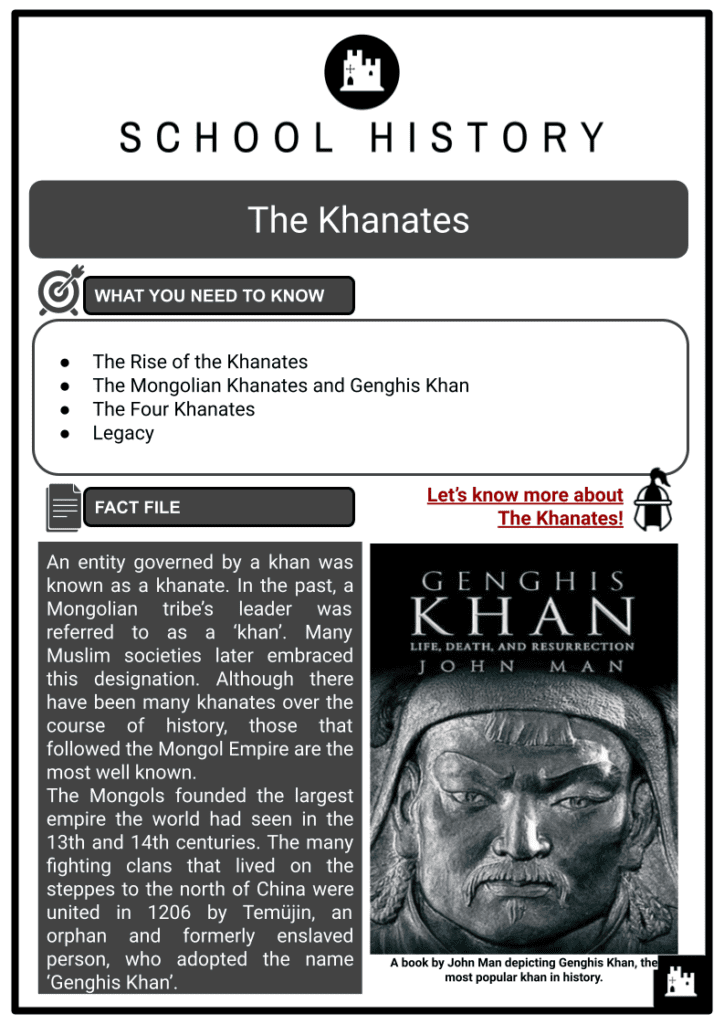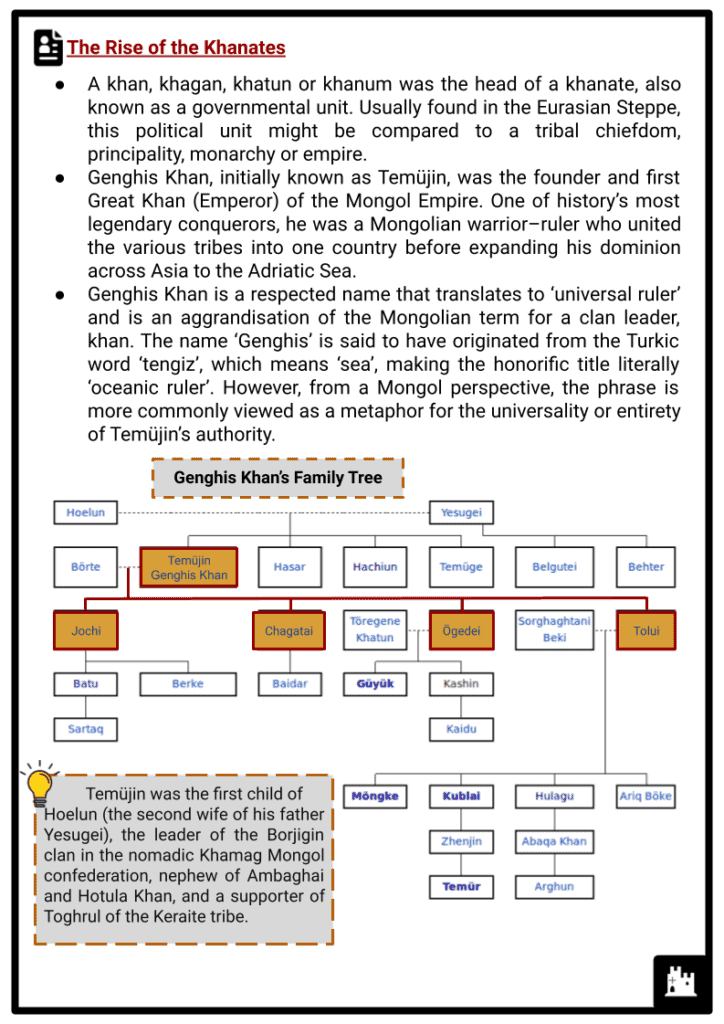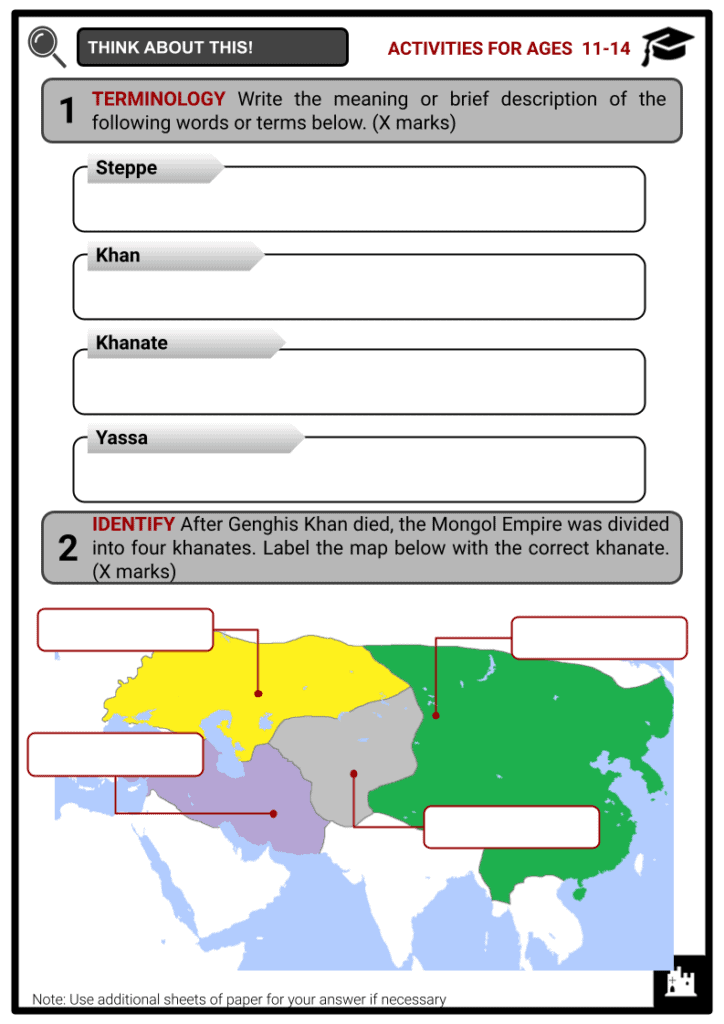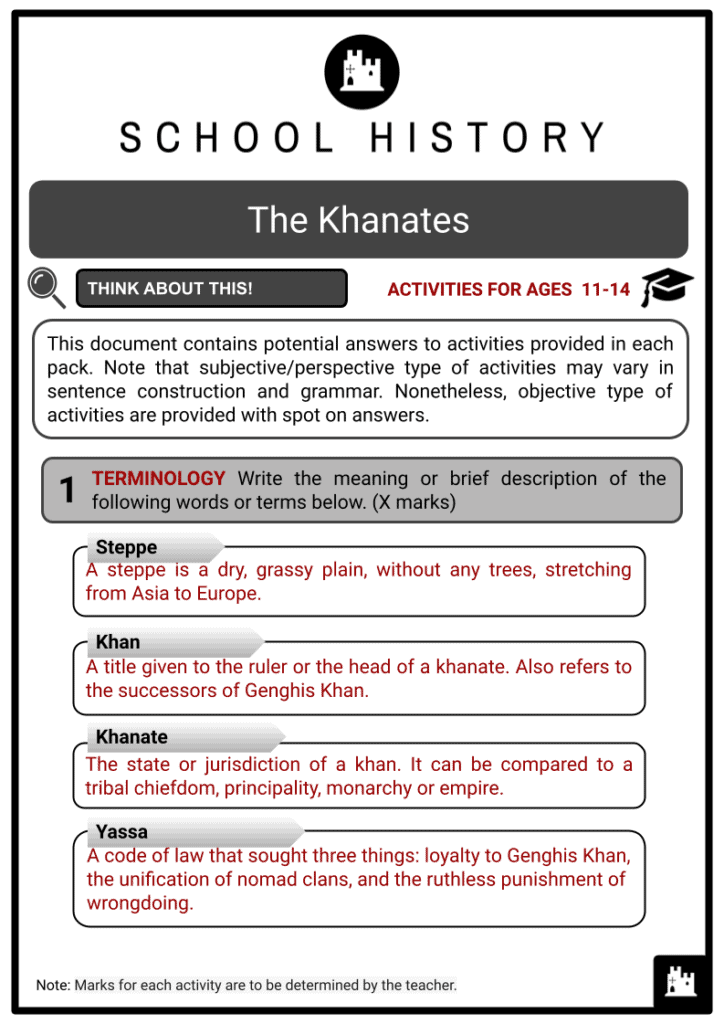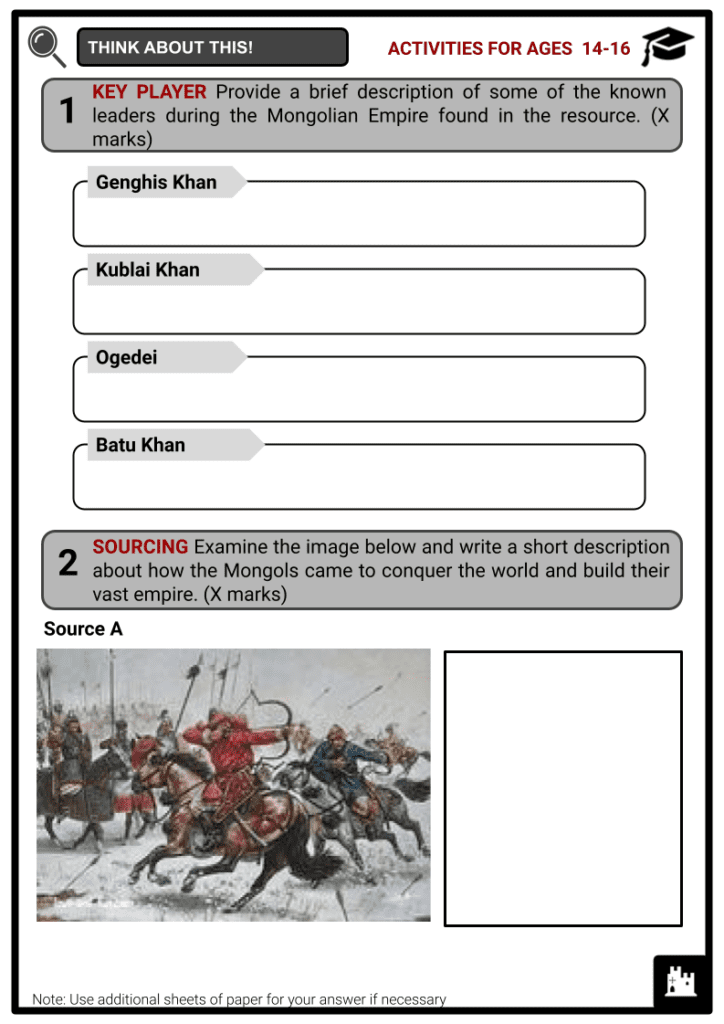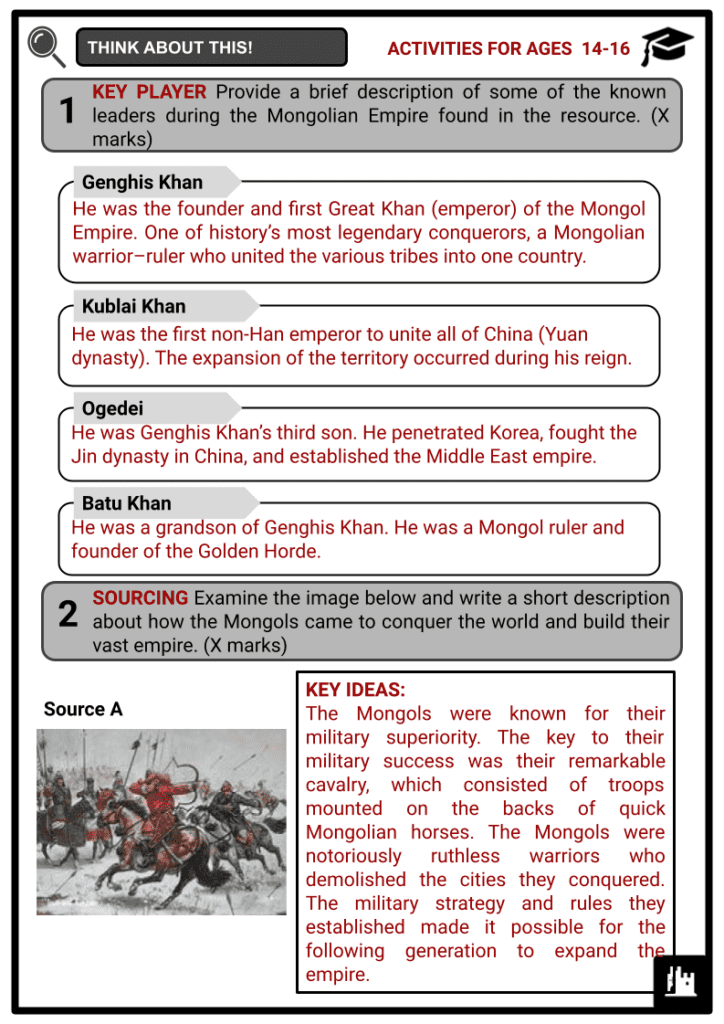The Khanates Worksheets
Do you want to save dozens of hours in time? Get your evenings and weekends back? Be able to teach about The Khanates to your students?
Our worksheet bundle includes a fact file and printable worksheets and student activities. Perfect for both the classroom and homeschooling!
Summary
- The Rise of the Khanates
- The Mongolian Khanates and Genghis Khan
- The Four Khanates
- Legacy
Key Facts And Information
Let’s find out more about the Khanates!
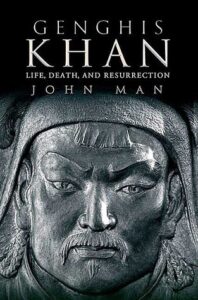
An entity governed by a khan was known as a khanate. In the past, a Mongolian tribe’s leader was referred to as a ‘khan’. Many Muslim societies later embraced this designation. Although there have been many khanates over the course of history, those that followed the Mongol Empire are the most well known.
The Mongols founded the largest empire the world had seen in the 13th and 14th centuries. The many fighting clans that lived on the steppes to the north of China were united in 1206 by Temüjin, an orphan and formerly enslaved person, who adopted the name ‘Genghis Khan’.
The Rise of the Khanates
- A khan, khagan, khatun or khanum was the head of a khanate, also known as a governmental unit. Usually found in the Eurasian Steppe, this political unit might be compared to a tribal chiefdom, principality, monarchy or empire.
- Genghis Khan, initially known as Temüjin, was the founder and first Great Khan (Emperor) of the Mongol Empire. One of history’s most legendary conquerors, he was a Mongolian warrior–ruler who united the various tribes into one country before expanding his dominion across Asia to the Adriatic Sea.
- Genghis Khan is a respected name that translates to ‘universal ruler’ and is an aggrandisation of the Mongolian term for a clan leader, khan. The name ‘Genghis’ is said to have originated from the Turkic word ‘tengiz’, which means ‘sea’, making the honorific title literally ‘oceanic ruler’. However, from a Mongol perspective, the phrase is more commonly viewed as a metaphor for the universality or entirety of Temüjin’s authority.
- Temüjin was the first child of Hoelun (the second wife of his father Yesugei), the leader of the Borjigin clan in the nomadic Khamag Mongol confederation, nephew of Ambaghai and Hotula Khan, and a supporter of Toghrul of the Keraite tribe.
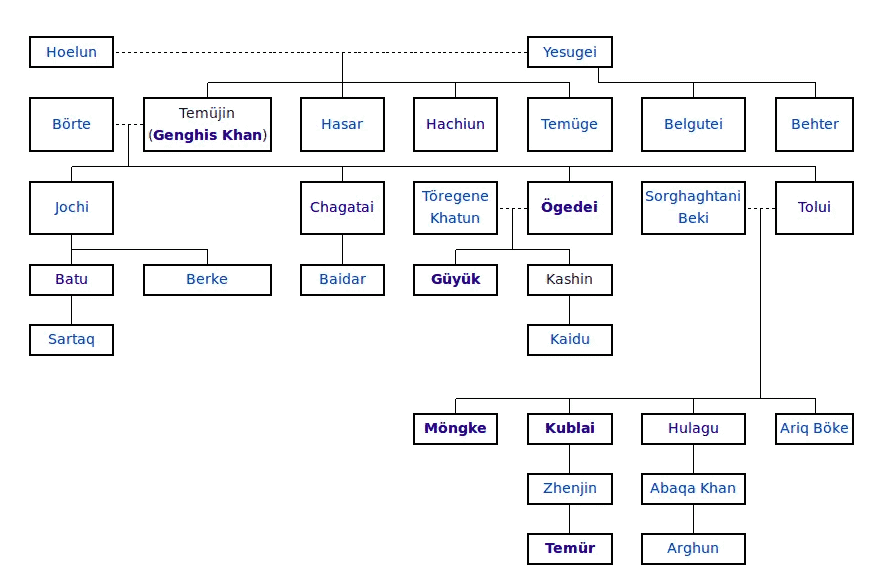
Genghis Khan’s Family Tree - Börte, 1161–1230. Grand empress of the empire and the wife of Temüjin. Although Börte was not Temüjin’s only spouse, they appear to have been exceptionally close. She served as his valued counsellor and was in charge of her own region.
- Jochi, 1181–1227. Given that he was born too soon after Börte’s return to her husband, he might not have been Temüjin’s child. His brothers never acknowledged him as their father’s lawful heir. Jochi received the westernmost portion of Genghis Khan’s dominion when he partitioned his empire, a region that would later form the Golden Horde in modern-day Russia.
- Chagatai, 1183–1242. He was seen as a hothead by his brothers and was the most vocal opponent of Jochi. His father left him the Central Asian portion of the empire, later known as the Chagatai Khanate. He liked airag, an alcoholic beverage made of fermented horse milk.
- Ögedei, 1186–1241. Genghis Khan’s third son and successor as a middle ground between Jochi and Chagatai. He penetrated Korea, fought the Jin dynasty in China, and established the Middle East empire. The Mongols began to invade Europe during his rule.
- Tolui, 1192–1232. Was Genghis Khan’s eldest son. The traditional Mongol heartlands were passed down to him from his father. Until 1691, his ancestors governed Mongolia.
The Mongolian Khanates
- The most contiguous land empire ever was the Mongol Empire, which existed in the 13th and 14th centuries. The Mongol Empire is now called Mongolia in East Asia, and at its height spanned from the Sea of Japan to parts of Eastern Europe. It extended northwards into parts of the Arctic, and eastwards and southwards into the Indian subcontinent. They attempted invasions of South East Asia. The Mongols captured the Iranian Plateau and went westwards as far as the Levant and the Carpathian Mountains.
- Temüjin started his rise to power by proposing to be an ally (a vassal – according to other sources) to his father’s blood brother Toghrul, who was then the Khan of Keraites. When Merkits abducted Börte sometime around 1184, Temüjin sought Toghrul’s assistance to win her back, and this event strengthened their friendship. Toghrul responded by offering 20,000 of his Keraite troops and advising Temüjin to work with Jamukha, the khan of his tribe, the Jadaran.
- The Pax Mongolica in Latin means ‘Mongol Peace’, which refers to a time of relative prosperity in Eurasia during the 13th and 14th centuries under the rule of the Mongol Empire. During Pax Mongolica, the people who lived in the conquered land reached a period of stability.
- Genghis Khan, recognised by a council in 1206 as the head of all Mongols, led the unification of many nomadic tribes in the Mongol heartland, which became the Mongol Empire. The empire expanded as they dispatched invading armies in all directions. In an imposed Pax Mongolica, the empire linked the East with the West, the Pacific with the Mediterranean. It allowed the movement of trade, technology, goods and ideas throughout Eurasia.
The Mongolian Khanates and Genghis Khan
- Temüjin deviated significantly from Mongol tradition throughout his tenure and his defeat of hostile tribes. He distributed power based more on merit and loyalty rather than family ties.
- Temüjin offered wealth from future war spoils to troops and civilians as a reward for complete dedication and adherence to the Yassa code of law. When he routed opposing tribes, he did not expel their army or leave their civilians behind. Instead, he protected the conquered tribe and included its members in his clan.
- Even orphans from the conquering tribe would be adopted by his mother and brought into his family. The conquered population exhibited remarkable allegiance due to these political changes, strengthening Temüjin with each victory.
- The Yassa sought three things: loyalty to Genghis Khan, the unification of nomad clans, and the ruthless punishment of wrongdoing.
- Yassa was the oral legal system of the Mongols, which Genghis Khan announced in public in Bukhara as the de facto law of the Mongol Empire, although the ‘law’ was kept secret and never made public.
- The Yassa appears to have started as orders issued during a conflict and eventually grew to incorporate cultural and societal norms. The decrees can be altered and applied only sometimes by keeping the Yassa a secret. Genghis Khan tasked Chagatai Khan, his second son, with overseeing the law’s implementation.
- Genghis Khan made numerous inventive military organisational innovations. He organised the men into ‘arban’ groups of ten chosen from different aspects of Mongol society. Then Genghis Khan mandated that every arban live and fight as devotedly as brothers.
- The government viewed each group of ten men as a family and not only as the primary military unit but also as social life. The ten groups were then multiplied by ten to create groups of 100, 1,000 and 10,000 soldiers. A tumen, or 10,000 men, or soldiers, was a unit of military organisation.
- The Mongol Empire had a reputation for defeating its rivals, brutal warfare, and the tales of the cities they had destroyed spread horror and panic.
- The empire started to break apart due to wars over succession. Genghis Khan’s grandchildren disputed whether the royal line should go to his son Jochi and the heir of Ögedei or among Tolui and Chagatai.
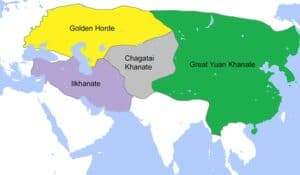
Image depicting the Mongol Empire expansion
The Four Khanates
- In 1206 Genghis Khan became the leader of the Mongols and established an empire that encompassed a vast portion of southern Asia.
- Genghis Khan’s sons became rulers of four khanates or kingdoms upon his death in 1227: the Great Khanate (China), the Chagatai (Turkmenistan), the Hulagu (Persia), and the Golden Horde (southern Russia).
- The empire continued to develop under this new arrangement, but the greatest expansion occurred under the reign of Genghis Khan’s grandson, the renowned Kublai Khan.
Great Khanate / Yuan Dynasty
- The Great Yuan dynasty reigned over one-fifth of the world’s dry land, and its territory spanned from the Pacific Ocean to the Ural Mountains, from Siberia to Afghanistan.
- When Genghis Khan passed away in 1227, he left a portion of his kingdom to his son Ogedei Khan. Ogedei and the rest of his dynasty conquered the Jin dynasty with the aid of the Song dynasty in China. In 1234, the Jin dynasty collapsed.
- Genghis Khan’s grandson, Kublai Khan, eventually governed the Mongol Empire from 1260 to 1294. He is well known for establishing the Yuan dynasty, subduing Song China, and becoming Emperor of China in 1271.
- The Yuan dynasty ruled over present-day Mongolia, China and Korea. Kublai Khan became the first non-Han emperor to unite all of China.
- In 1272, Dadu (now Beijing) was named as the capital.
- During this time, Kublai successfully established a strong empire, and the ‘four great achievements’ of ancient science and technology papermaking, printing, the compass and gunpowder – were further developed and introduced to other nations, significantly advancing global civilisation.
- Numerous new art, theatrical and literary forms were developed during the Yuan dynasty. Shadow puppet performances are an example of a traditional type of theatre. A lamp was used to project the shadows of puppets onto a screen. Plays with shadow puppets were regarded as some of the best forms of entertainment at the time.
- Another entertainment genre that gained popularity during the Yuan dynasty was opera.
The Decline of the Yuan Dynasty
- The native Chinese population was undoubtedly unhappy with Mongol rule and, as time passed, uprisings against the empire increased in frequency. The empire eventually disintegrated as a result of the Mongol army’s inability to suppress ongoing uprisings since it was no longer as powerful as it once was. The Yuan dynasty lasted from 1271 until 1368 when the Ming dynasty defeated the Yuan forces.
- Toghon Temur, the last Mongol emperor, was expelled from China in 1368, and the Yuan dynasty was overthrown.
- Mongol emperors fled to their native Mongolian homeland and remained in power as the Northern Yuan dynasty.
Chagatai Khanate
- The Chagatai Khanate was run by Genghis Khan’s second son, Chagatai Khan. It included most of Kazakhstan, Uzbekistan, and western Xinjiang, as well as parts of northern Afghanistan and Tajikistan. Its capital was Almaliq and Qarshi.
- Before the Yuan dynasty fell in the late 14th century, this khanate was part of the Mongol Empire. Later, it became completely independent.
- Tsagadai Khan governed his empire from 1227 to 1242, when he died. Chagatai and his wife Ebuskun had three sons: Mutukan, Baidar and Yesü Mongke. Chagatai, however, designated his grandson Qara Hülgü as his heir, with Ebuskun serving as the young man’s regent.
- Despite having few natural resources, this khanate was able to trade and collect taxes because a portion of the Silk Road passed through its territory. Silk Road is neither a road nor a single route. The phrase instead refers to a network of commercial routes used for more than 1,500 years, from 130 BCE, when the Han dynasty of China opened commerce, until 1453 CE when the Ottoman Empire cut off trade with the West.
- The Chagatai Khanate was also divided into two separate, contrasting regions: the east and west. The western region was more Islamised and developed than the eastern region, which was significantly more pastoral and animistic.
- Chagatain leaders began to convert to Islam in the 14th century, marking the beginning of the Mongols’ assimilation with the Turkic population they dominated. Turkic people practised Islam and spoke Turkic as their native language.
- Eventually, the Chagatain leaders replaced Mongolian with Chagatai Turkic as the official language of the khanate.
- In one form or another, the khanate lasted from the 1220s until the late 17th century. Ultimately, the Khanate was conquered by external enemies and fell.
Ilkhanate
- The Mongol House of Hulagu ruled the Ilkhanid realm, officially known as Iranzamin, which means ‘Land of Iran’.
- The term ‘Ilkhanate’ refers to the ruler of the entire empire by the great khan, Mongke, meaning subordinate khan.
- Afghanistan, Iran, Iraq, Turkmenistan, Armenia, Georgia, Azerbaijan, Turkey and Pakistan were all part of the Ilkhanate, which was based in Persia.
- Its capital was Maragheh (1256–1265), Tabriz (1265–1306) and Soltaniyeh (1306–1335).
- This khanate was established by Hulego Khan, a grandson of Genghis Khan. For over 100 years, Hulego and his descendants oversaw the Ilkhanate. They were all shamanists at first, then Buddhists, and finally Muslims.
- In this region, the rise of the Ilkhanate had a significant impact. The Mongol Empire improved trade and commerce throughout Asia. The development was promoted by the communications between the Ilkhanate and the Yuan dynasty, which was located in China.
- Similar to the Yuan dynasty, the Ilkhanate era saw numerous new breakthroughs and accomplishments in terms of culture and the arts.
- The Ilkhanate population began to place more and more value on literature.
- With the extensive use of paper and textiles, new forms and media of writing were developed. Religious texts were created and rewritten. Motifs and other literary elements were included in poetry.
- Textiles, pottery, metals and jewellery are a few further decorative art forms.
- Hulego died in 1265, and his son Abaqa Khan succeeded him. At the end of the 13th century, the khanate’s rulers converted to Islam, although their religions alternated between Sunni and Shia.
- Abu Sa’id Bahadur Khan, the final monarch of the Ilkhanate, died without an heir in 1335. As a result, the khanate’s cohesiveness was dissolved and, until 1353, several rulers ruled over its former
borders.
Golden Horde
- In 1242, Batu Khan, Jochi’s son, officially formed the Golden Horde. At its height, the Golden Horde controlled the Volga region, the Ural Mountains, the northern Black Sea steppes, Western Siberia, the Aral Sea, and the Irtysh Basin.
- The Golden Horde was the longest-lasting of all Mongol khanates, lasting 250 years, and producing more than 150 exquisite luxury cities, open and unhindered passage from the Pacific to the Mediterranean, and state and monetary policies.
- He made the city of Sarai, near the Volga River, the capital.
- The Golden Horde’s citizens enjoyed a more established than nomadic existence.
- Sarai swiftly grew in population, but the capital was relocated to Sarai Berqe in the early 14th century, which was further upstream of the Volga River than Sarai.
- Sarai Berqe had a population of 600,000 people at its peak. The Golden Horde’s people and government were originally animists, but Uzbeg Khan, the greatest khan, accepted Islam and made it the state’s official religion. Sarai Berqe relied on trade and tribute for a living.
- They conducted trade with the Malmuk Egypts and the Genoese on the Black Sea, and the Russians, Armenians, Georgians, and Crimean Greeks paid taxes to the government.
- The Golden Horde’s downfall began in 1346 when the Black Death made its way to Asia.
- The assassination of Uzbeg Khan’s successor was another factor in its collapse. The Russian princes defeated General Mamai of the Horde.
- Most of the skilled craftsmen from the khanate were exiled to Central Asia after Sarai Berqe was conquered and destroyed.
- The Golden Horde was ultimately divided into a number of lesser khanates, including Crimea, Astrakhan and Kazan. The Black Death (known as the Plague) was an epidemic of bubonic Plague that devastated Afro-Eurasia between 1346 and 1353. It is the deadliest pandemic documented in human history, killing 75–200 million people in Eurasia and North Africa, with its peak in Europe between 1347 and 1351.
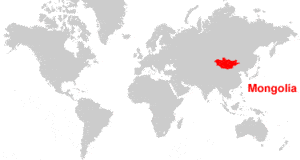
Mongolia today
Legacy
- The Mongol Empire was the world’s most extensive contiguous Empire. The 13th and 14th centuries, when the empire rose to dominance, are often referred to as the ‘Age of the Mongols’.
- Mongol armies were extraordinarily highly structured at the time. According to some historians, the death toll of the Mongol conquest wars (by fighting, massacre, inundation and famine) was around 40 million.
- The adoption of a writing system based on the Uyghur script, which is still used in Inner Mongolia, was one of the Mongol Empire’s non-military successes.
- The empire united all of Mongolia’s tribes, allowing the creation of a Mongol nation and culture. Mongolians nowadays are usually proud of the empire and the sense of identity it provided them.
Image Sources
- https://www.goodreads.com/book/show/93427.Genghis_Khan
- http://ringmar.net/irhistorynew/index.php/welcome/introduction-4/from-temujin-to-genghis-khan/genghis-khans-family-tree/
- https://www.northcoastjournal.com/humboldt/the-golden-horde/Content?oid=21448232
- https://geology.com/world/mongolia-satellite-image.shtml

